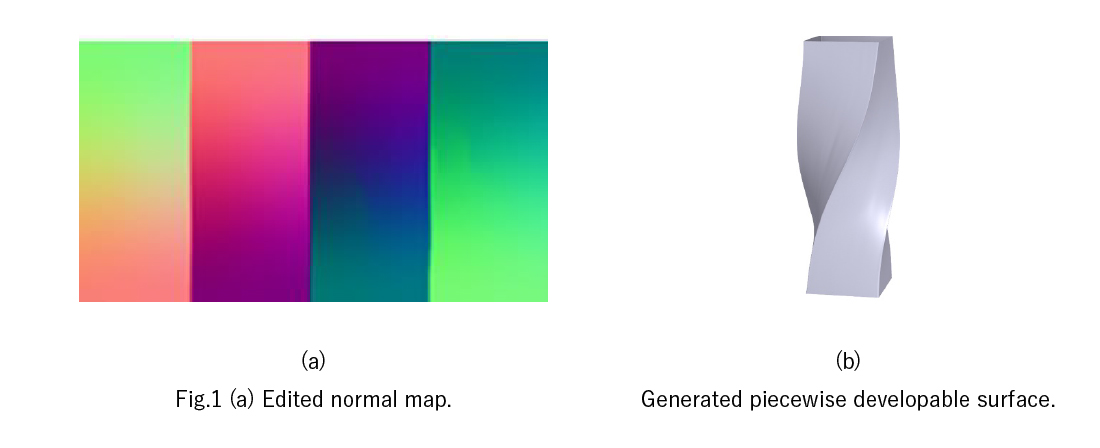Research Contents
Maekawa Group
Research Items
There is an urgent need of innovative researches on generation of the free surfaces in the architecture and shipbuilding design. In this project we propose a method to approximate the given surface by the piecewise developable surfaces from processing the curve normal map images.
- Establishment of approximation of free surfaces by the developable surfaces which is the essential part of this project.
- Two-dimensionalization of the surface information by processing the normal map images.
- Clarification of dividing lines by the smoothing of edge support.
- Generation of developable surfaces based on the solution of the optimization problem.
Outline
- We draw the dividing lines in the parameter space of the free surfaces represented by NURBS to map the dividing lines to the surface. We then draw the direction curve in the direction of the osculating Darboux vector along the mapped curves and approximate the free surface by the developable surfaces. In the example of Fig.1(a), we divide the area into four by drawing three dividinv lines in the parameter space. We intend the synergy effect by the collaborated researches with Mitani Group studying the discrete representation method of geometric shapes and its interactive design. Also, we will work jointly with Miura Group on the shape of dividing lines.
- We compute the unit normal vectors on the surface corresponding to the free surface of the piecewise developable surfaces. Arranging RGB colors to each pixel according to the values of x,y,z components of the unit normal vector (nx, ny,nz) to draw the normal map image (see Fig.1(a)). In general, the length on the surface and the length of u,v-parameters (on the pixels). Therefore, we need to produce the normal map images after dividing the surfaces into the areas where the parametric speed, namely, the ratio of change of the length on the surface corresponding to the parameters, is constant. If we ignore the computational time, it is possible to carry out by choosing the small grid intervals. In this manner, it is possible to apply the various image processing technologies by transforming the three-dimensional information into two-dimensional images via the normal of the surface.
- Since it is the requirement to be the developable surface that the normal are constant along the directional curves, it is possible to edit the image further by putting the constraint that they are of the same color. Also, it is possible to make the division line clearer to apply the edge supporting smoothing filter to the image.
- Based on the normal of the edited normal map, we construct the objective function under the constraint that the two tangents on the surface and the normals are orthogonal and that the displacement from the control points from the original free surface. We solve the optimization problem with the control points being the unknown variables to generate the piecewise smooth surface (see Fig.1(b)). We plan to adopt the Bound Optimization BY Quadratic Approximation (BOBYQA) method (Powell (2009)), which does not require the gradient of the objective function.
Placement in the project
Differential geometry of the developable surfaces has been widely studied in mathematics, while the studies of the piecewise developable surfaces have just begun. Many problems are still left for applying the piecewise developable surfaces to the practical structures of architecture and shipbuilding. For example, the choice of materials, manufacturability, productivity, and durability are essential problems for practical use. In this project, we develop a method to generate the piecewise developable surfaces via the image processing of the normal map of the free surfaces ahead of the world. The generation of the surfaces can be understood comprehensively as the inverse problem to recover the surface from the normal map (Gauss map) from the standpoint of pure mathematics. Such understanding is essential to organize the support of the construction of geometry of the piecewise smooth surfaces from the viewpoint of the inverse problems, which is indispensable for the achievement of the goals of the whole project. Also, the collaborations on the free surfaces for the industrial design with Miura Group enables the design of the free surfaces with high artisticity by the piecewise developable surfaces, which is expected to bring a big breakthrough in the industrial design.

References
- T. Maekawa and J. S. Chalfant, “Design and Tessellation of B-Spline Developable Surfaces”,
Journal of Mechanical Design, ASME Transactions, 120 (3) pages 453-461, 1998. - J. S. Chalfant and T. Maekawa, “Design for Manufacturing Using B-Spline Developable Surfaces”, Journal of Ship Research, 42 (3) pages 206-214, 1998.
- T. Maekawa and J. S. Chalfant, “Computation of Inflection Lines and Geodesics on Developable Surfaces”, Mathematical Engineering in Industry, 7 (2) pages 251-267, 1998.
- G. Yu, N. M. Patrikalakis and T. Maekawa, “Optimal Development of Doubly Curved Surfaces”, Computer Aided Geometric Design, 17 (6) pages 545-577, 2000.
- M. Takezawa, T. Imai, K. Shida, and T. Maekawa, "Fabrication of freeform objects by principal strips" ACM Transactions on Graphics 35 (6) 225, 2016.
- T. Kawasaki, P. K. Jayaraman, K. Shida, J. Zheng and T. Maekawa, “An Image Processing Approach to Feature-Preserving B-Spline Surface Fairing”, Computer-Aided Design, 99, pages 1-10, 2018


 Return to Top Page
Return to Top Page